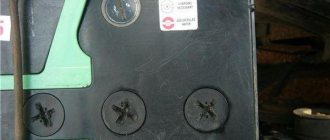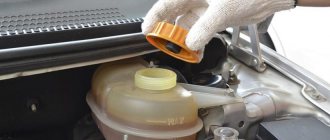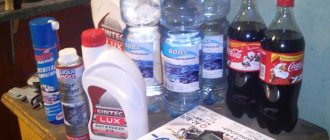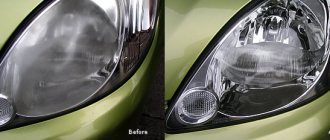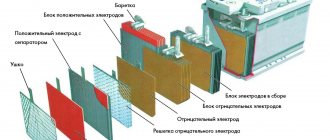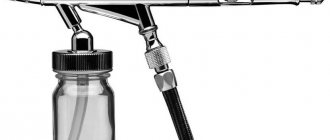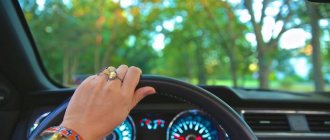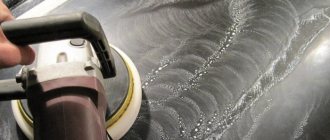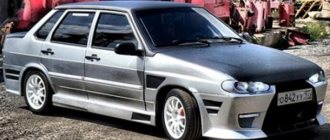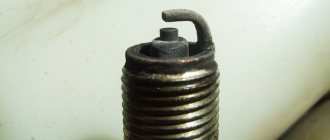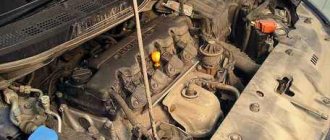If any malfunction appears in the front suspension of a car, the first thing any motorist must check is the support bearing. It is located between the upper spring cup and the support itself. To do this, just grab the “cup” of the rack with your hand and shake the car a little.
Constantly sharply changing loads, as well as shock loads and abrasive dust particles, contribute to bearing wear. Ultimately, all this can cause complete failure. As a result, the shock absorber rod begins to deviate from its axis, and the bearing will creak, knock, play and squeak. Wear of the support bearing leads to a violation of the wheel alignment angles. As a result, vehicle controllability decreases and tire wear accelerates.
Where is the support bearing located?
The support bearing is an intermediate link connecting the shock absorber strut to the body.
In most cars, the support bearing is visible from the engine compartment, but in some cars the support bearing is located under the dashboard (for example, Fiat Ducato).
With severe wear, it is quite simple to calculate the source of extraneous noise.
Turn the steering wheel all the way
Without starting the car, it is enough to turn the steering wheel to the left all the way, and then to the right all the way. If a characteristic crunch is heard, then the support bearing is in very poor condition and requires immediate replacement.
But if the bearing wear is weak, you may not hear a crunch, so the diagnostic method, which I will discuss below, is more suitable.
To calculate even the slightest crunch of a support bearing, you will need the help of a partner.
Support bearing diagnostics
Holding the shock absorber strut spring (for example, the right one) with your hand, ask your partner to turn the steering wheel to the right until it stops, and then to the left. Even a slight biting of the bearing will be reflected into the spring and you will feel it with your hand.
Check the right side and then the left side one at a time. If faults are detected in the support bearings, they must be replaced as soon as possible.
You will find useful materials, as well as car repair manuals, in my VK group. You can join the group using this link
.
Replacement
- jack;
- wheel wrench;
- open-end wrench 19;
- open-end wrench 17;
- socket wrench 13;
- pliers;
- ring wrench 22 and open-end wrench 9;
- special puller for tie rod ends;
- 2 special spring ties.
Execution order
- We park the car on a level surface and put it in gear.
- We jack up its front part on the desired side and remove the wheel.
- Using pliers, unscrew the nut securing the steering tip to the strut and unscrew it with a 19 mm wrench.
- Using a tip remover, remove the tip pin from the shock absorber strut. As a last resort, the finger can be knocked out by prying it up with a small pry bar and carefully tapping it from below.
- Using a 19mm wrench, unscrew the 2 nuts securing the strut to the steering knuckle. If necessary, hold the bolt heads with a 17 wrench.
- Using a 13 mm socket wrench, unscrew the 3 nuts securing the support to the body.
- We remove the entire shock absorber.
- We install two ties on the shock absorber spring and compress it until the upper part of the shock absorber is released.
- Using wrenches 22 and 9, unscrew the upper support nut on the upper side of the shock absorber.
- We remove the support, disassemble it, and remove the worn support bearing.
- We install a new one in its place.
- We install the shock absorber in the reverse order.
Types of support bearings
There are several most popular types of bearings used in modern cars. These include:
- bearing with built-in ring. This arrangement of the front strut support bearing is considered the most convenient to install. The built-in ring can be external or internal. The main feature of this type of bearings is the presence of special holes for installation. Its installation does not require the use of clamping flanges. The bearing ensures the rotation of parts using both the inner and outer rings;
- with outer detachable ring. The inner ring provides connection to the vehicle body;
- with detachable inner ring;
- single divided. This type of bearing is practically no different from all others, but its peculiarity is that it is made of more durable materials.
This is interesting: Wiring diagram for the VAZ 2106 generator - how to connect it yourself
What is the danger of a breakdown and when is replacement needed?
Many car enthusiasts underestimate the importance of this unit and ignore the knocking noise of the support bearing. This, in turn, can end very badly.
For example, during the next collision with a hole, the support may break. As a result, the car pillar breaks through the hood. If this happened at low speed, then the only costs are material.
It will be necessary to straighten or change the hood, paint it, and so on. It is much worse if such a situation occurs while moving. In this case, the consequences can be more tragic.
If the support gear malfunctions, many motorists do not know what to do correctly and what to do in such a situation. Here the answer is clear - the front strut supports need to be replaced.
If there is an obvious knock, there can be no talk of any repairs (more expensive). Many beginners are afraid of such work, considering replacement to be too complicated a process.
In fact, all manipulations take a minimum of time. The main thing is to know exactly the sequence of actions.
Be careful and do not ignore the appearance of suspicious knocking noises. Remember that such problems can not only lead to additional costs, but also pose certain health hazards. Good luck on the roads.
Causes of support bearing failure
Among the main causes of support bearing failures, poor road quality should be highlighted, as a result of which dirt gets inside the device, since it is not equipped with any protective devices. It is very difficult to determine the cause of the malfunction based on hearing or personal feelings, in what sequence and how to check the front strut support bearing on your own, but it is still possible:
- Turn off the car engine
- Put the handbrake on (if it doesn’t work, put wheel chocks under the wheels)
- Open the hood
- Remove the glass lid
- Place your hand on the support bearing and have someone rock the car slightly from side to side. At the same time, so that the car rack does not “play”
If you hear knocking, creaking or crunching noises - even the slightest - when rocking, then most likely the support bearing of the strut has failed and you need to replace it . This procedure is recommended not only when extraneous noise appears or vehicle controllability deteriorates, but also for preventive purposes. Many manufacturers recommend carrying out such diagnostics every 15-20 thousand km.
Rear support
Malfunction of the rear support bearing and its failure is possible in the following cases:
- Wear by mileage;
- Moisture getting inside;
- Late suspension maintenance;
- Driving on bad roads, exposure to dust, dirt;
- Strong shocks (breakdowns) of the suspension when hitting a deep hole;
- Exceeding the maximum permissible weight of cargo placed in the trunk and rear seat.
Front support
Aggressive driving style, poor road conditions or a defective part most often causes a breakdown. Failure occurs earlier for the following reasons:
- Driving on dusty roads.
- Low quality spare parts.
- Natural wear and tear.
- Sharp turns of the steering wheel, drift;
- Sudden braking immediately before an obstacle.
- Wear of the rubber elastic seal.
- Loosening the mounting bolts.
- Malfunction of strut elements (spring, shock absorber, buffer, etc.).
Checking the condition of the chassis and transmission
We check the condition of the chassis and transmission every 15 thousand kilometers. The parts of the chassis (wheels, suspension arms, anti-roll bar, rear suspension beam, shock absorbers and suspension springs) and transmission (front wheel drive shafts) must be free of deformations, cracks and other mechanical damage that affect the shape and strength of the parts. Hanging the front wheels one by one (while the car must be securely fixed on the support stand), we check the condition of the wheel hub bearings.
Use only factory-made support stands. The wheel should rotate evenly by hand, without jamming or knocking.
Holding the wheel in a vertical plane, we alternately sharply pull the upper part of the wheel toward ourselves, and the lower part away from us, and vice versa. We make sure there is no play (knock). If there is a knock on the front wheel, ask an assistant to press the brake pedal. If the knocking noise disappears, then the wheel bearing is faulty, and if the knocking noise remains, then the ball joint is most likely worn out. The hub bearings of the front and rear wheels are not adjustable and must be replaced if there is play. To check the serviceability of the ball joint, insert a mounting blade between the suspension arm and the ball joint housing. Be careful not to damage the ball joint boot.
While pressing the lever with a mounting blade, we monitor the movement of the lever head relative to the ball joint housing. If there is play in the connection, replace the ball joint.
We check the condition of the protective covers of the ball joints. We replace ball joints with torn or cracked covers. To check the silent block of the front suspension arm...
...insert a mounting blade between the body bracket and the lever head... ...and try to move the lever along its axis and along the axis of the bolt. If the lever moves freely, without effort, it means that the silent block of the lever is badly worn or damaged and needs to be replaced. Ruptures, cracking and swelling of the rubber bushing of the silent block are unacceptable. Checking the condition of the silent blocks...
... and the back ends of stretch marks. Tearing, cracking and swelling of rubber silent blocks are unacceptable.
Inspecting the anti-roll bar cushions...
...and rubber bushings for stabilizer struts. If ruptures, cracks or severe deformation are detected on the rubber pads and bushings, they must be replaced. Lifting the rear wheels one by one, we check the condition of the rear wheel hub bearings. The wheel should rotate evenly by hand, without jamming or knocking. To check the condition of the silent block of the rear suspension beam arm...
...we insert the mounting blade between the body bracket and the lever head and try to move the lever in different directions. If the lever moves freely, without effort, it means that the silent block of the lever is badly worn or damaged and needs to be replaced.
We check the condition of the springs, telescopic struts and shock absorbers of the front and rear suspensions. The suspension springs must not be damaged. Tearing, cracking and severe deformation of rubber bushings, cushions and compression buffers of shock absorbers are unacceptable. Liquid leakage from shock absorbers is not allowed. A slight “fogging” of the shock absorber in its upper part, while maintaining the characteristics, is not a malfunction. If the rubber element of the upper support of the front suspension telescopic strut settles or is destroyed, the support must be replaced.
We check the condition of the hinges and the protective cover of the gear shift rod and jet rod. Alternately rotating and turning the front wheels (with the front of the car hanging out)…
...we inspect the protective covers of the outer...
...and internal hinges of the front wheel drives, check the reliability of their fastening with clamps. Covers that are cracked, torn or have lost elasticity must be replaced. We check that there is no oil leakage from the gearbox through the seals of the internal drive joints. If there is a leak, replace the seals.
How to check the knock of the prop on VAZ cars
Before replacing a part, make sure that it has actually failed. On VAZ cars, the condition of the racks and supports should be checked 1-2 times a year. This is what auto mechanics advise in service centers. You can use a fairly simple method, but it will require 2 people. The degree of wear of the support bearing can be determined quite accurately by following these steps.
To clearly demonstrate the verification process, watch the video:
Checking the “supporters” on VAZs
Creaking noise when turning the steering wheel
Checking and operation for a specific car model
You can find specific inspection and operating instructions for a specific car model on our website. Further in the navigation table, you can find and go to instructions for diagnosing and replacing support bearings for your car.
At what interval should a support bearing be diagnosed?
Various manufacturers set their own limits on the service life of this part, which experiences fairly high loads during vehicle operation. The average limit is limited to a mileage of 100,000 km. Taking into account the condition of the roadway, this could be 50,000 km or less. Typically, replacement of a part is required once every 2-3 years.
But in practice, it is necessary to change as a squeak appears, when the maximum degree of wear is reached. Well, the check should be carried out annually, after 20,000 km - mandatory. Moreover, it is not difficult to do this.
